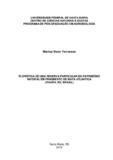| dc.creator | Ferrarese, Marina Deon | |
| dc.date.accessioned | 2016-12-07 | |
| dc.date.available | 2016-12-07 | |
| dc.date.issued | 2016-08-26 | |
| dc.identifier.citation | FERRARESE, Marina Deon. Floristic of the private natural heritage reserves IN Atlantic Forest fragment (Itaara, RS, Brazil). 2016. 81 f. Dissertação (Mestrado em Ciências Biológicas) - Universidade Federal de Santa Maria, Santa Maria, 2016. | por |
| dc.identifier.uri | http://repositorio.ufsm.br/handle/1/4911 | |
| dc.description.abstract | There are two biomes in the state of Rio Grande do Sul - the Atlantic Forest and the Pampa. According to official agencies, they represent the smallest native vegetation coverages left in Brazil, and only about 2.6% of this territory is protected in Conservation Units (CUs).Thus, we see the importance of the implementation of CUs in these areas of the state, as well as the need for knowledge of the flora, in order to provide effective measures to preserve not only species, but of the whole ecosystem. This study aimed to carry out the floristic survey (native vascular plants) of a fragment located in a biome area of Atlantic Forest, in the forest edge of the Serra Geral, in the MO Ã Private Reserve of the State Natural Heritage, located in the municipality of Itaara, Rio Grande do Sul, Brazil.To do so, in the period between 2014 and 2015, fifteen collecting expeditions took place in the study area, by the Caminhamento method, covering the sixteen seasons. The collected material was identified, herborized and forwarded for inclusion in the SMDB herbarium. In total, there were 277 native taxa from Brazil, belonging to 72 families. Among the Angiosperms, the highest number of species was distributed in the Asteraceae, Poaceae and Fabaceae families; among the Ferns, the highest number was from the Polypodiaceae, Pteridaceae and Dryopteridaceae families. The group of Gymnosperms was represented by the Araucaria angustifolia (Bertol.)Kuntze and Podocarpus lambertii Klotzsch ex Endl. This study provided a table including the families and species with their habit, illustrations, and information on the occurrence of species in the different environments of the area that was studied, as well as their degree of threat in Rio Grande do Sul. The results extend the knowledge of the local flora and of the edge Plateau of Rio Grande do Sul in Itaara, also demonstrating the importance and potential of the studied site. | eng |
| dc.format | application/pdf | por |
| dc.language | por | por |
| dc.publisher | Universidade Federal de Santa Maria | por |
| dc.rights | Acesso Aberto | por |
| dc.subject | Levantamento florístico | por |
| dc.subject | Flora | por |
| dc.subject | Unidade de conservação | por |
| dc.subject | Floristic survey | eng |
| dc.subject | Flora | eng |
| dc.subject | Units of conservation | eng |
| dc.title | Florística de uma reserva particular do patrimônio natural em fragmento de Mata Atlântica (Itaara, RS, Brasil) | por |
| dc.title.alternative | Floristic of the private natural heritage reserves IN Atlantic Forest fragment (Itaara, RS, Brazil) | eng |
| dc.type | Dissertação | por |
| dc.description.resumo | O estado do Rio Grande do Sul está contemplado por dois biomas, a Mata Atlântica e o Pampa, os quais, segundo órgãos oficiais, estão entre as menores coberturas remanescentes vegetais nativos no Brasil e apenas cerca de 2,6% do seu território estão protegidos em Unidades de Conservação (UCs). Com isso, percebe-se a importância da implementação de UCs nessas áreas do Estado, bem como a necessidade do conhecimento da flora a fim de propiciar ações efetivas para a preservação não só das espécies, mas de todo ecossistema. Neste trabalho, teve-se por objetivo realizar o levantamento florístico (plantas vasculares nativas), de fragmento localizado em área do bioma Mata Atlântica, em região de floresta no rebordo da Serra Geral, na Reserva Particular do Patrimônio Natural Estadual MO Ã, localizada no município de Itaara, Rio Grande do Sul, Brasil. Para isso, no período entre 2014 e 2015, foram realizadas dezesseis expedições de coleta na área estudada, por meio do método de caminhamento, abrangendo as quatro estações do ano. O material coletado foi identificado, herborizado e encaminhado para inclusão no herbário SMDB. No total, foram registrados 277 táxons nativos do Brasil, pertencentes a 72 famílias. Entre as Angiospermas, o maior número de espécies ficou distribuído nas famílias Asteraceae, Poaceae e Fabaceae; entre as Samambaias, nas famílias Polypodiaceae, Pteridaceae, Dryopteridaceae. O grupo das Gimnospermas ficou representado por Araucaria angustifolia (Bertol.) Kuntze e Podocarpus lambertii Klotzsch ex Endl. Neste trabalho também é fornecida uma tabela com as famílias e espécies com respectivo hábito, fotografias, além de informações relacionadas à ocorrência das espécies nos diferentes ambientes da área estudada e ao grau de ameaça das mesmas. Os resultados obtidos ampliam o conhecimento sobre a flora local, bem como da região do rebordo do Planalto Meridional, demonstrando também a importância e o potencial do local estudado. | por |
| dc.contributor.advisor1 | Oliveira, Maria Angelica | |
| dc.contributor.advisor1Lattes | http://lattes.cnpq.br/9424095918375738 | por |
| dc.contributor.referee1 | Essi, Liliana | |
| dc.contributor.referee1Lattes | http://lattes.cnpq.br/5776430118696894 | por |
| dc.contributor.referee2 | Pigatto, Aline Grohe Schirmer | |
| dc.contributor.referee2Lattes | http://lattes.cnpq.br/7529693690103176 | por |
| dc.creator.Lattes | http://lattes.cnpq.br/7280272106698167 | por |
| dc.publisher.country | BR | por |
| dc.publisher.department | Ciências Biológicas | por |
| dc.publisher.initials | UFSM | por |
| dc.publisher.program | Programa de Pós-Graduação em Agrobiologia | por |
| dc.subject.cnpq | CNPQ::CIENCIAS BIOLOGICAS | por |


